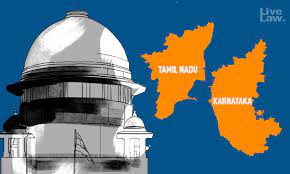
PENNAIYAR RIVER WATER DISPUTE
PENNAIYAR RIVER WATER DISPUTE I RACE IAS : Best IAS Instituute coaching in Lucknow I Current Affairs
Mains General Studies:2 and 3
(Inter-state river water dispute and environmental challenges)
Why in News?
- According to recent reports, the three-month deadline set by the Supreme Court for setting up an Inter-State River Water Disputes Tribunal for the Pennaiyar river has expired, Tamil Nadu awaits the next step of the central government.
Main points:
- The Supreme Court in December directed the Center to set up a Pennaiyar River Water Disputes Tribunal within three months to resolve the dispute over sharing of water between Karnataka and Tamil Nadu.
- In 2018, Tamil Nadu filed a lawsuit against Karnataka for building check-dams and diversion structures on the river.
- On November 30, 2019, Tamil Nadu formally requested the central government to set up a tribunal to settle disputes over the river's water.
- In mid-December 2022, the Supreme Court gave the Center three months to set up a tribunal to resolve the dispute between Tamil Nadu and Karnataka.
Inter-state River Water Dispute:
- Interstate river water disputes are currently one of the most contentious issues in Indian federalism.
- River water disputes between states in India are always in the news.
- Till now several Inter-State Water Disputes Tribunals have been constituted.
- Article 262 of the Constitution deals with the adjudication and adjudication of inter-state water disputes.
- Under Article 131 of the Constitution, the Supreme Court in its original jurisdiction decides a dispute between the Government of India and one or more states or between the Government of India and any state or states or river water disputes between two or more states .
About Pennaiyar River:
- This river originates from the Nandi Hills in Chikkaballapura district of Karnataka and flows through a large area of Tamil Nadu before disappearing into the Bay of Bengal.
- Chinnar, Markanda, Vaniyar and Pamban are its major tributaries.
- The total length of this river is 597 km which is the second longest river in Tamil Nadu after Kaveri.
- It is the second largest interstate east flowing river basin among the 12 basins located between the Pennar and Kaveri basins.
- Most of the flow area of this river is in Tamil Nadu but it also covers the states of Karnataka and Andhra Pradesh.
- Bangalore, Hosur, Tiruvannamalai and Cuddalore are situated on the banks of this river.
Inter-State River Water Disputes in India:
Ravi-Beas water dispute
- States concerned: Punjab, Haryana and Rajasthan
Narmada river water dispute
- States concerned: Madhya Pradesh, Gujarat, Rajasthan and Maharashtra
Godavari Water Dispute
- States concerned: Maharashtra, Andhra Pradesh, Odisha, Madhya Pradesh and Karnataka
Krishna river water dispute
- States concerned: Andhra Pradesh, Karnataka and Maharashtra
Cauvery Water Dispute
- States concerned: Kerala, Karnataka, Tamil Nadu and Puducherry
Mahadai Water Dispute
- States concerned: Goa, Karnataka and Maharashtra
Krishna river water dispute
- States concerned: Karnataka, Telangana, Andhra Pradesh and Maharashtra
Basandhara river water dispute
- Related States: Andhra Pradesh and Odisha
Dispute resolution methods:
Interstate Council-
- The River Board Act, 1956 mentioned in Entry 56 of the Union List for its implementation is a powerful law which needs to be amended. Under this Act, Basin Organization can be established for regulation and development of inter-state rivers and their basins.
Taking steps for mediation-
- In the context of South Asia, the World Bank has played a very important role in successfully resolving the Indus Basin Rivers dispute between India and Pakistan. Similarly, there should be some role to mediate between the states.
Declaring rivers as national property-
- The demand to declare rivers as national property has been made for a long time. This will curb the tendency of states to consider river water as their right.
Inclusion of water in concurrent list-
- Based on the Mihir Shah report prepared in the year 2014, in which the Central Water Authority has been recommended for water management. This recommendation has also been supported by the Parliamentary Standing Committee.
Institutional model for issues related to interstate waters-
- There is a need for a permanent mechanism or institutional model at the national level by which water disputes between states can be resolved without recourse to the judiciary.
Adopting the 4 R's-
- 4 R (Reduce, Reuse, Recycle, Recover) should be used for water management.
Following the National Water Policy-
- Provision for proper use of water and conservation of water sources under the National Water Policy.
Interlinking of rivers-
- It can help in adequate distribution of river water in the basin areas.
Conclusion:
- Water is a national asset. The talk of territorial sovereignty over river water is illogical. No state can lay claim to the ownership of the river. The principle of 'equitable distribution or use' of water should be emphasized for the resolution of river water disputes.
- There is a need to set up a permanent tribunal in place of separate tribunals between the states for quick resolution of inter-state river water disputes.
- The shortcomings of the Inter-State River Water Disputes Act should be removed.
----------------------------------------------------------
Mains Exam Question:
Mentioning the major inter-state river water disputes in India, write the measures for the resolution of inter-state river water disputes.
Pre. Exam Question:
With reference to the Pennaiyar river water dispute, consider the following statements-
- This river water dispute is between the states of Karnataka and Tamil Nadu.
- Article 262 of the Constitution deals with the adjudication and adjudication of inter-state water disputes.
Which of the statements given above is/are true?
- 1 only
- only 2
- Both 1 and 2
- Neither 1, nor 2
Answer: Option C